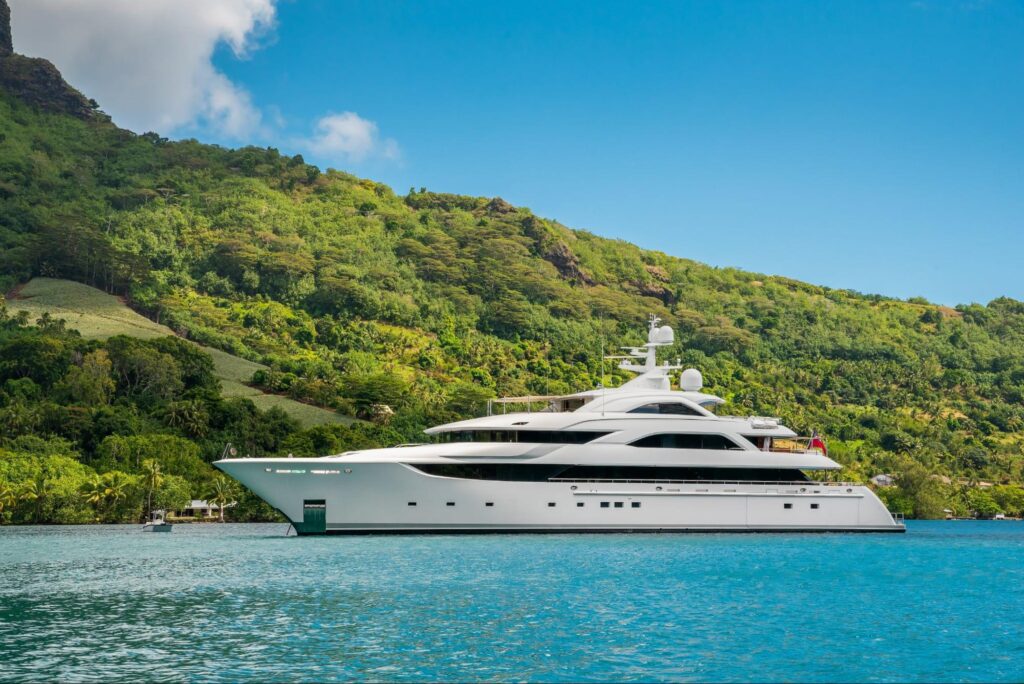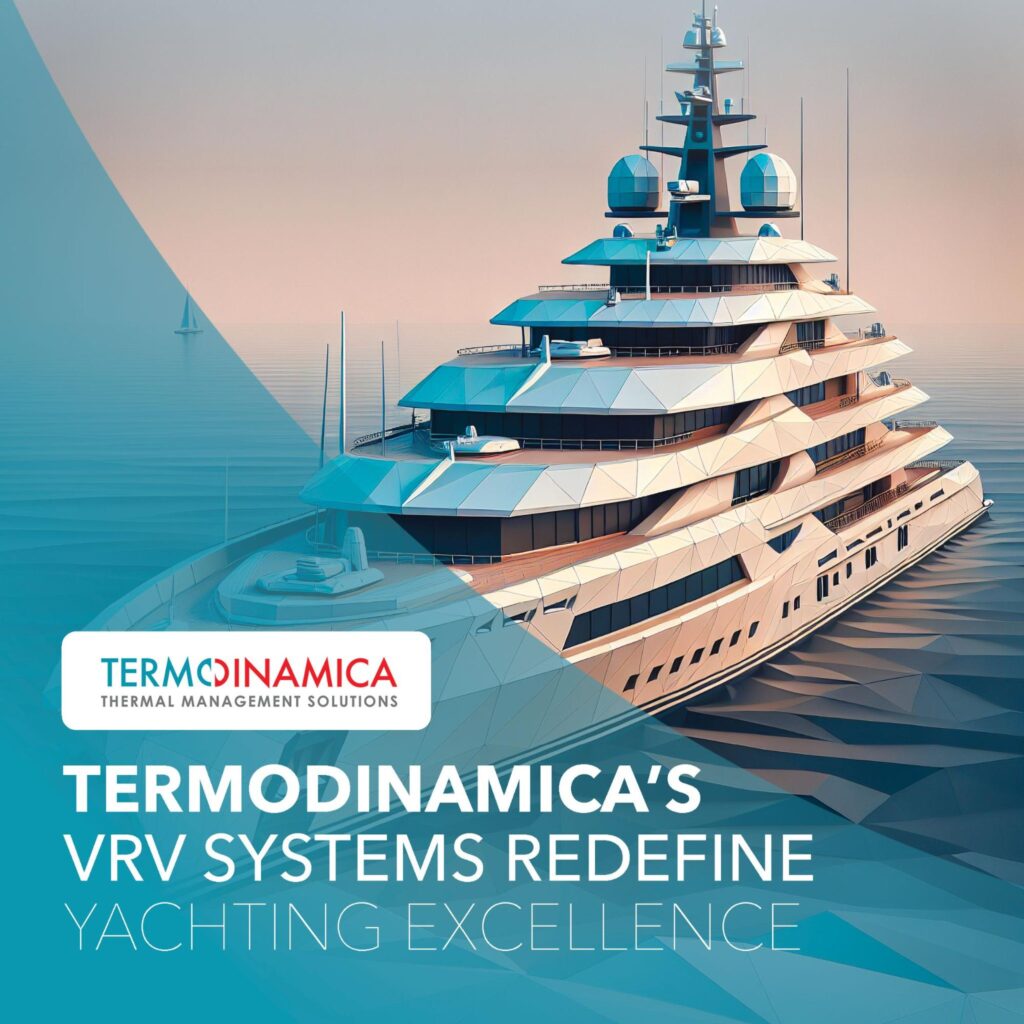Traditional marine air conditioning systems often are limited by complex piping systems, multiple compressors, and water-based connections. These factors can lead to inefficiencies, increased maintenance costs, and environmental concerns. To address these challenges, Termodinamica has embraced Variable Refrigerant Volume (VRV) technology, an innovation transforming the way marine cooling is approached.
Understanding VRV Technology
While traditional air conditioning systems typically rely on a centralised compressor to distribute refrigerant to various rooms, VRV technology introduces a new advancement. By offering users control over their individual cooling needs, VRV systems revolutionise the way room temperatures are controlled. This precision is achieved through advanced inverter technology, which enables the compressor to modulate its output in real time, ensuring that refrigerant flow is precisely tailored to each unit’s requirements. Unlike conventional systems that often struggle to deliver optimal comfort in different spaces, VRV empowers users, enhancing both comfort and energy efficiency.
Read about the technology we use here.
Key Features of VRV in Marine AC
- Multiple air handlers with direct expansion system: The VRV system uses multiple air handlers, each equipped with a direct expansion coil. This eliminates the need for complex piping networks and water-based connections, simplifying installation and maintenance.
- Single compressor, unlimited capacity: The centralised compressor in a VRV system provides ample cooling capacity, meeting the demands of various marine environments without the need for multiple compressors. This reduces equipment complexity and energy consumption.
- Waterless connection: VRV systems operate without water-based connections between the compressor and air handlers. This is a significant advancement as it eliminates the risk of water leaks and associated maintenance issues. Small size pipes can be routed through the yacht, allowing for important space saving. The technology is especially useful for retrofits where a large water pipe leaves space for a gas pipe three times smaller.
How it Works:
- Capacity on demand compressor: The compressor receives capacity requests from the air handlers via a databus and adjusts its speed accordingly.
- Refrigerant Flow: The compressed refrigerant flows through pipes to the individual air handlers.
- Expansion Valve: At each air handler, an expansion valve regulates the flow of refrigerant into the evaporator coil. The valve enables precise flow control without energy loss. Each fan coil can operate across a wide temperature range.The valve enables precise flow control without energy loss. Each fan coil can operate across a wide temperature range.
- Heat Exchange: As the refrigerant flows through the evaporator coil, it absorbs heat from the indoor air, cooling it down.
- Humidity control: By adjusting the coil temperature, the system can efficiently control the dehumidification process in super energy-saving mode without the need for electric re-heating.

Advantages of VRV for Marine Applications
- Enhanced energy efficiency: A VRV system’s ability to precisely match cooling output to demand results in significant energy savings, translating to lower operating costs and a reduced environmental footprint.
- Improved flexibility: The modular design of VRV systems allows for easy expansion and customisation to meet individual cooling needs. This flexibility is particularly valuable in boats where space constraints and varying requirements are common.
- Simplified maintenance: The streamlined design and fewer components minimise maintenance requirements. This results in less downtime for vessel operations and lower maintenance costs.
- Environmental benefits: By eliminating water-based connections and reducing energy consumption, VRV technology’s ability to precisely match cooling output to demand results in significant energy savings. This means less reliance on fossil fuels and a lower carbon footprint. VRV systems can also be designed to use more environmentally friendly refrigerants with lower global warming potentials (GWP).
Want to find your nearest dealer?

Termodinamica’s VRV Solutions
Termodinamica has successfully implemented VRV technology in a wide range of marine applications, including:
- Luxury yachts: VRV systems in yachts provide precise temperature control and energy efficiency required to create a comfortable and luxurious environment for passengers. It’s also imperative for crew to work in a comfortable and cool environment to maintain morale and energy.
- Cruise ships: The ability to handle large cooling loads and accommodate diverse spaces makes VRV ideal for cruise ships.
- Commercial vessels: VRV systems offer reliable and efficient cooling solutions for various commercial vessels, such as cargo ships and fishing boats.
VRV technology represents a significant advancement in marine air conditioning. By offering enhanced energy efficiency and reliability, VRV systems are transforming the way marine cooling is approached. Termodinamica’s ever evolving commitment to developing VRV technology has positioned the company as a leading provider of advanced air con solutions. Considering the substantial energy and fuel savings, ranging from $500,000 per year for a 70-meter motor yacht to $20 million per year for a 300-meter cruise ship, VRV technology is at the forefront of sustainable HVAC systems. As the marine industry progresses, VRV will undoubtedly play a crucial role in shaping the future of marine climate control. This technology will be making a significant impact on operations of all vessels, improving the overall comfort of crew and guests on boats of all sizes.
Contact us today for more information on how VRV systems can improve your onboard experience.


